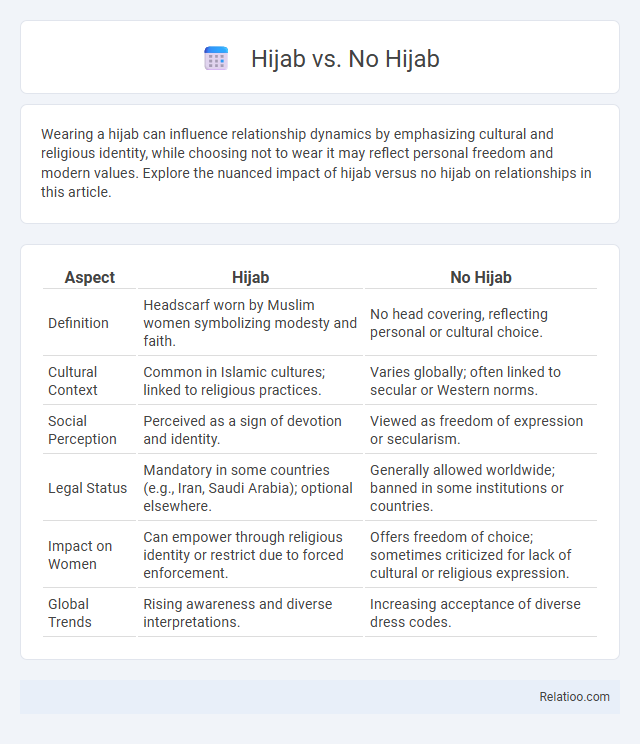Wearing a hijab can influence relationship dynamics by emphasizing cultural and religious identity, while choosing not to wear it may reflect personal freedom and modern values. Explore the nuanced impact of hijab versus no hijab on relationships in this article.
Table of Comparison
| Aspect | Hijab | No Hijab |
|---|---|---|
| Definition | Headscarf worn by Muslim women symbolizing modesty and faith. | No head covering, reflecting personal or cultural choice. |
| Cultural Context | Common in Islamic cultures; linked to religious practices. | Varies globally; often linked to secular or Western norms. |
| Social Perception | Perceived as a sign of devotion and identity. | Viewed as freedom of expression or secularism. |
| Legal Status | Mandatory in some countries (e.g., Iran, Saudi Arabia); optional elsewhere. | Generally allowed worldwide; banned in some institutions or countries. |
| Impact on Women | Can empower through religious identity or restrict due to forced enforcement. | Offers freedom of choice; sometimes criticized for lack of cultural or religious expression. |
| Global Trends | Rising awareness and diverse interpretations. | Increasing acceptance of diverse dress codes. |
Introduction to the Hijab Debate
The Hijab debate centers on personal freedom, cultural identity, and religious expression, contrasting those who choose to wear the hijab with individuals who do not, while some societies enforce specific dress codes. Your perspective shapes how you navigate the balance between respecting individual choice and adhering to communal or institutional norms. This ongoing discussion touches on women's rights, societal expectations, and the intersection of faith and modernity.
Historical Roots of the Hijab
The hijab traces back to ancient civilizations such as Mesopotamia and Persia, where veiling denoted social status and modesty among women. Historically, the hijab evolved through Islamic jurisprudence and cultural practices, emphasizing modesty as outlined in the Quran and Hadith. Dress codes across cultures vary widely, but the hijab remains a distinct symbol that reflects religious identity, cultural norms, and personal choice throughout history.
Cultural Significance of Wearing the Hijab
The hijab holds deep cultural and religious significance in many Muslim communities, symbolizing modesty, identity, and spiritual devotion. Unlike general dress codes that often prioritize professional or social norms, the hijab represents a personal and collective expression of faith and cultural heritage. Wearing or not wearing the hijab can influence perceptions of cultural belonging, individual agency, and societal acceptance within diverse global contexts.
Personal Choice: Why Some Women Wear the Hijab
Wearing the hijab is a personal choice influenced by faith, cultural identity, and individual expression, reflecting a woman's autonomy over her dress code. For many, the hijab symbolizes modesty and spiritual connection, while others opt for no hijab to assert freedom or personal comfort. Your decision to wear or not wear the hijab navigates complex social norms and personal beliefs, emphasizing respect for diverse perspectives on clothing and identity.
Reasons for Choosing Not to Wear the Hijab
Reasons for choosing not to wear the hijab often include personal freedom, comfort, and cultural identity, with many women prioritizing individual expression over religious mandates. Some individuals reject the hijab due to feminist beliefs, viewing it as a symbol of oppression rather than empowerment. Legal constraints and social environments also influence the decision, as in countries where hijab laws are strict or where wearing it may lead to discrimination, many opt for alternative dress codes.
Misconceptions and Stereotypes About Hijab
Misconceptions about the hijab often wrongly portray it as a symbol of oppression, ignoring its significance as a personal and cultural expression of faith and identity. Stereotypes suggest that women who choose not to wear the hijab lack modesty or religious commitment, which oversimplifies diverse individual choices and beliefs within Muslim communities. Your understanding of dress codes should recognize the complexities and respect the autonomy behind choosing to wear or not wear the hijab without resorting to generalized assumptions.
Legal and Political Perspectives on Hijab
Legal and political perspectives on the hijab vary widely, with some countries enforcing strict dress codes that mandate or ban the hijab to align with national identity or secular policies. Court rulings and legislative measures often highlight conflicts between religious freedoms and state interests, impacting Your ability to choose personal attire without discrimination. These regulations reflect broader political debates about multiculturalism, gender rights, and social cohesion in diverse societies.
The Role of Society and Family in Hijab Decisions
Society and family play a crucial role in shaping your decision to wear a hijab, as cultural norms and familial expectations often influence personal choices. Community values and traditions can either encourage or discourage hijab adoption, impacting individual expression and identity. Understanding the dress code within specific social environments highlights the ongoing dialogue between personal freedom and collective cultural heritage.
Impact of Hijab on Identity and Empowerment
Hijab symbolizes cultural identity and personal empowerment by allowing individuals to express faith and values visibly, often fostering a strong sense of self and belonging. Choosing to wear or not wear the hijab shapes social perceptions and personal confidence, influencing how you navigate societal expectations and dress codes. The impact of the hijab on identity intertwines with empowerment, as it represents autonomy in defining one's image amid diverse cultural and institutional dress standards.
Moving Forward: Respecting Individual Choices
Respecting individual choices regarding hijab, no hijab, and dress codes fosters inclusive environments that honor personal beliefs and cultural identities. Emphasizing autonomy in clothing decisions supports freedom of expression while promoting mutual understanding across diverse communities. Moving forward, policies and attitudes should prioritize acceptance and dignity, enabling individuals to wear what aligns with their values without judgment or discrimination.

Infographic: Hijab vs No Hijab
 relatioo.com
relatioo.com